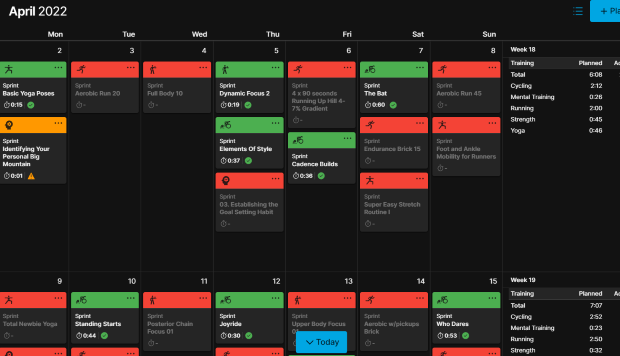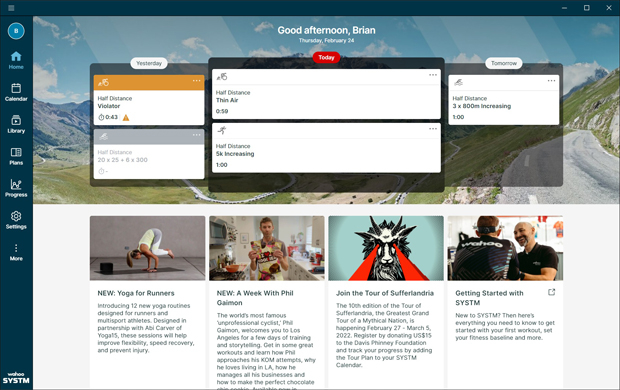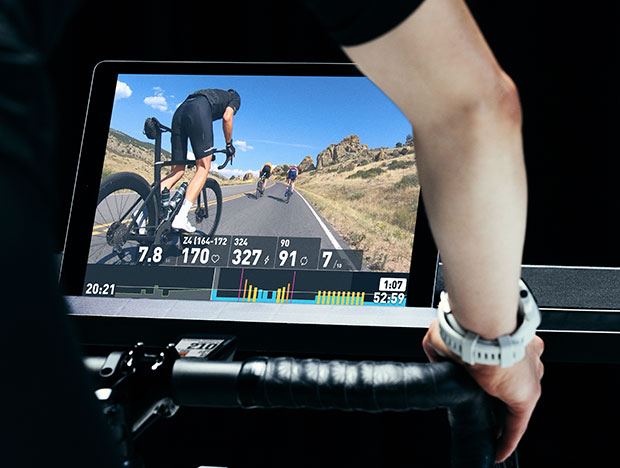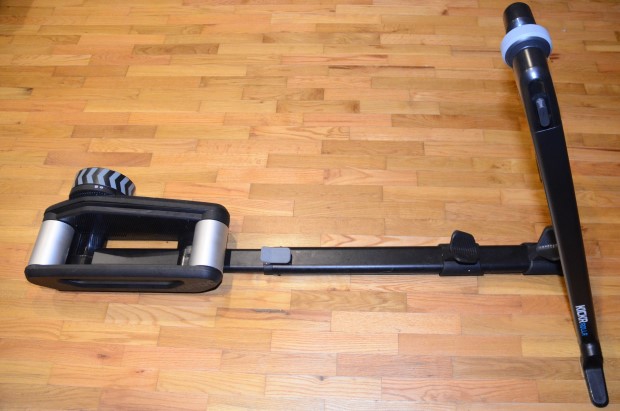Wahoo SYSTM: A Second Look

Disclaimer: I am a coach for QT2 Systems, and while Wahoo SYSTM not the same type of coaching product that we offer, there is a small amount of overlap. I have done my best to take off my QT2-colored lenses and evaluate SYSTM objectively.
So the first question… what is Wahoo SYSTM? Some kind of new trainer? No, no it isn’t. It’s Wahoo’s entry into the coaching/scheduling/motivation space, and it’s delivered via an app that can be downloaded to any PC/tablet/phone. Big picture, it plans workouts for you, and then delivers them in a video format that’s become popular with many home fitness products. The above is a view as to what you’d see on your screen during a typical workout:
–Target HR and Actual HR
–Target Power and Actual Power
–Target Cadence and Actual Cadence
–Target Perceived Exertion
Then they layer these metrics over a video of people cycling (or a bike race), and you’ve got yourself a fairly immersive workout experience.
So that’s all well and great, but what is it like to actually use? I hopped on it for a few weeks to find out, and I’ll walk you through my experience.
Download, Installation and Initial Set-up
Downloading was incredibly easy across all of my devices: an Android Tablet, a Windows PC, and an iPhone. Total time for all three was probably less than a minute.
Once inside SYSTM, you have a relatively unexciting account creation experience. Just enter your basic details — height, weight, recent training experience, how much time you have to train, and what your target event is. I have 1.5 jobs, a family, and a psychotic dog, so I chose “3-6 hours training per week”, with “sprint duathlon” as my goal race. Next thing I knew, there was a calendar page with all of my planned training posted for the next few months.
Part of the initial setup was an FTP and MAP test. This was going to be my first chance to really evaluate the accuracy/engineering behind SYSTM. So I hopped on my trainer (Wahoo KICKR Snap), put it in ERG mode, and let SYSTM take control.
SYSTM took me through a warmup and then a fairly standard ramp test protocol. At the end of it, it said my FTP was 310 W and MAP was 388 W — numbers that are about what I’d expect. I’ll give the engineering/accuracy rating a 10/10 here.
The Training Schedules
The training itself was pretty simple (not easy… but simple). You just wake up in the morning, see what’s on the schedule, and execute it. For runs and swims, there is no connectivity with the app. So you take the instructions from the app and go do the workout on your own. For strength/yoga sessions (which I was happy to see were included), you hit “play” on the workout and then follow along with a pre-recorded video of an instructor.

The bike training is where SYSTM gets interesting and impressive. When you start the app and open a workout, the Bluetooth sync between with your devices is quick and seamless. After that, you just get rolling. There are options to have the background video on or off, and while I generally chose to have the video off because sometimes it felt a little bit silly to try to pretend I was in some grand bike race while riding in a cramped 12’ x 7’ room, I’ll admit that that background video did help as motivation on some of the harder sessions.
And, fair warning on those harder sessions: SYSTM does not back off on the harder sessions… woof! All of the workouts are based on a percentage of your calculated FTP, and when you’re in ERG mode, you have no choice but to hit the numbers. This isn't like Zwift, where you can turn ERG mode on and off, or adjust the bias midway through. There are no 2 ways about it: some of the sessions are extremely tough, to the point where I failed on a couple before completing the planned workouts. As an aside: I personally dislike ERG mode because it’s easy to get caught in the "low cadence death spiral”, but that’s a personal thing and not a shortcoming of Systm). As a long course triathlete, it’s no surprise that I struggled most on the workouts that were extended threshold intervals with periodic sprints sprinkled in.
Overall the training had more intensity/threshold work than I’m used to, but that should probably be expected given that I told the program I only had 3-6 hours per week for training. With volumes that low, if you’re not doing a high proportion of your training at high intensity, you’re just not going to make very many gains. For the sake of curiosity, I also punched in some other goals (70.3 race distance, with 10-12 hours per week to train) to see what kind of training was prescribed. While I didn’t love the progression I saw laid out on the calendar as it seemed to ramp up run volume a bit too quickly, overall it seemed fine as a general roadmap that an athlete could tweak as necessary.
Final Thoughts
I have tremendous respect for the engineering and thought that went into designing SYSTM. Wahoo’s product design and engineering have impressed me ever since I first bought one of their trainers in 2013. The seamless integration of the SYSTM App with my KICK was great, as I didn’t have to think about anything during the workout except turning over the pedals. While I didn’t love the overall training structures offered, I do think SYSTM is pretty good as a tool to use for individual workouts. It’s not as good as an individual coach, but it’s also not trying to be an individual coach.
Bottom-line: if you want some sort of structure to keep you on a track and hold you accountable, then I think SYSTM is a great deal at $15/month.





Start the discussion at slowtwitch.northend.network